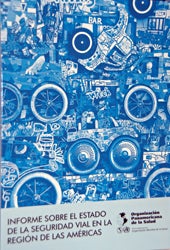
![]() In Latin America and the Caribbean, only a handful of countries have managed to reduce traffic death rates in the past decade, while North America has seen a steady decline in traffic deaths over the past 30 years, says a new report from the Pan American Health Organization (PAHO).
In Latin America and the Caribbean, only a handful of countries have managed to reduce traffic death rates in the past decade, while North America has seen a steady decline in traffic deaths over the past 30 years, says a new report from the Pan American Health Organization (PAHO).
Poor urban transport and planning put pedestrians and cyclists at greatest risk
Washington, D.C., June 4, 2010 (PAHO) — In Latin America and the Caribbean, only a handful of countries have managed to reduce traffic death rates in the past decade, while North America has seen a steady decline in traffic deaths over the past 30 years, says a new report from the Pan American Health Organization (PAHO).
 The contrast is due to factors ranging from the use of seatbelts, helmets and child safety seats to differences in legislation, law enforcement, and transportation and traffic planning.
The contrast is due to factors ranging from the use of seatbelts, helmets and child safety seats to differences in legislation, law enforcement, and transportation and traffic planning.
“While the majority of countries in the Americas are working to promote policies aimed at improving road safety, progress is clearly different in different countries,” said PAHO Director Dr. Mirta Roses in presenting the new Report on Road Safety in the Americas. The publication, currently available only in Spanish, is part of a global effort led by the World Health Organization (WHO) to assess road safety progress in different regions.
The report shows that traffic injuries are a major public health problem in all countries of the Western Hemisphere. They are a leading cause of death, particularly for age groups between 5 and 44 years, claiming the lives of 142,252 people each year and injuring 5 million more, leaving many with permanent disabilities.
“In addition to the suffering of victims and their families, we must recognize that this situation adds significantly to the demand for pre-hospital medical attention and trauma care, overburdens healthcare services, and exacts a high toll on society in lives lost and physical and mental disabilities,” said Dr. Roses.
The report’s key findings include:
- In North America, 74 percent of those killed in traffic incidents are automobile drivers or passengers.
- In Latin America and the Caribbean, more than half of traffic fatalities are pedestrians, motorcyclists or bicyclists.
- Between 75 percent and 80 percent of traffic deaths in the Americas are boys or men.
- Adjusted traffic mortality rates in the region range from a low of 4.3 per 100,000 inhabitants in Uruguay to more than 20 per 100,000 in Mexico, Peru, and Venezuela.
- Of 17 countries that submitted data on seat-belt use, 12 reported over 60 percent use by all vehicle occupants (15 countries did not collect data on seat-belt use).
- Eighty percent (26 out of 32) of countries report having a national agency dedicated to traffic safety, but only one-fourth report having an official, government-financed national road safety strategy.
- Fewer than half of countries have national policies that support investments in public transportation and promote non-motorized transport, such as bicycles.
- Fewer than half of countries collect information on the costs of road traffic injuries and deaths.
- Of all countries in the Americas, Costa Rica invests the most ($7.38) per capita in road safety, followed by the United States ($2.74 per capita).
“Those who are most affected are generally the most vulnerable (pedestrians, motorcyclists, and bicyclists) and, in most cases, the poorest,” the report notes. “These victims, mostly men and youths, have more difficulty accessing healthcare services when they are injured and are therefore less likely to fully recuperate and return to work or school.” In addition, traffic deaths and disabilities often leave families unable to support themselves, contributing to a “cycle of poverty,” says the report.
Among the report’s recommendations are:
- Laws that address the top risk factors for traffic deaths and injuries—speed, drunk driving, and the use of seat belts, helmets, and child safety seats—in an integrated fashion.
- Campaigns to increase public awareness of traffic safety issues.
- Policies that promote public transportation and nonmotorized transport.
- Better collection of information on traffic incidents to inform policymaking and to monitor progress.
CONTACT: Daniel Epstein, Tel. +1 202 974 3459, or Donna Eberwine-Villagran, Tel. +1 202 974 3122, Knowledge Management and Communication Area, PAHO/WHO.



